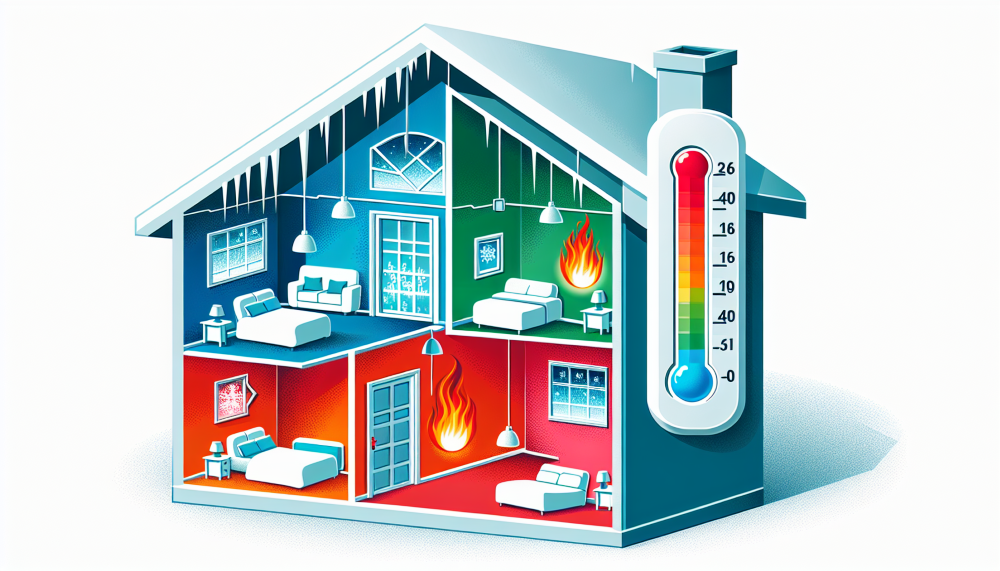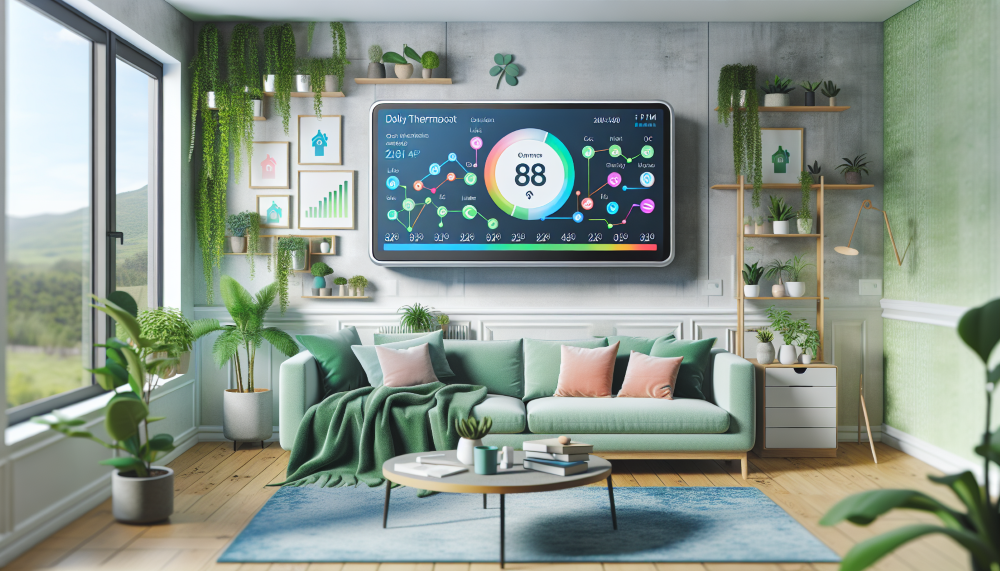Where Should My Thermostat Be Located
The right placement of your thermostat is essential for accurate temperature management and energy efficiency. A poorly placed thermostat can result in uneven room temperatures and higher energy bills. This article offers a thorough guide on where should my thermostat be located, providing the insights you need to ensure your HVAC system works seamlessly.
Key Takeaways
Thermostats should be centrally placed in your home, ideally on an interior wall to accurately assess and control the average temperature, avoiding direct sunlight, heat sources, exterior walls, and windows.
Incorrect thermostat placement can lead to false temperature readings, uneven heating or cooling in different rooms, increased HVAC system workload, and higher energy costs.
Smart thermostats require a strong Wi-Fi signal for full functionality, and for optimal performance should be placed at a height that accurately reflects the room temperature and in locations clear of obstructions for easy adjustments.
Decoding Thermostat Placement: Central Location Essentials
Thermostat placement plays a pivotal role in dictating the efficiency of your heating and cooling systems. To achieve an average temperature reading and efficiently maintain the desired temperature by your HVAC unit, a thermostat should be located centrally within your home. This central placement ensures proper air circulation and reduces fluctuations in temperature, which ultimately impacts the accuracy of your thermostat.
Ensure your thermostat’s placement is free from furniture or other obstructions. This allows for better airflow around the device, resulting in more accurate temperature readings. The key takeaway here is simple: Proper thermostat placement is a critical factor in ensuring the accurate functioning of your HVAC system.
Away from Direct Sunlight and Heat Sources
Direct sunlight and heat sources can be a thermostat’s worst enemy. These elements can cause false readings and trigger unnecessary cycling of your heating and cooling systems. To mitigate this, refrain from situating your thermostat near hot air vents or sunlight-exposed windows. Additionally, keep your thermostat away from heating appliances such as ovens, which can skew its readings.
Common heat sources, including HVAC supply vents, window air conditioners, and portable heaters, can impact your thermostat’s accuracy. Positioning your thermostat away from such heat sources facilitates more accurate temperature readings. This not only reduces the occurrence of ‘ghost readings’ but also lowers utility bills and ensures efficient heating and cooling.
On an Interior Wall
For thermostat installation, interior walls are the preferred choice. Exterior walls can result in false readings due to their typically cooler temperature, leading to inappropriate activation of your heating or cooling systems. Interior walls, on the other hand, provide more reliable temperature readings, ensuring that your thermostat can better manage your home’s temperature.
A centrally located thermostat on an interior wall yields the most representative readings for your house. This placement also helps prevent the device’s temperature sensors from experiencing drafts coming in from outside areas. Look for hallway walls that connect multiple rooms - they are ideal locations for thermostats as they are not impacted by the temperature fluctuations of exterior walls or windows.
In a Regularly Used Room
Installing a thermostat within a frequently used room guarantees accurate response of heating and cooling systems to occupants’ comfort needs. This minimizes ‘ghost readings’ from unoccupied areas. Avoid placing your thermostat in hallways or infrequently used rooms, which may not accurately represent the most lived-in areas of your home.
Positioning your thermostat in a room with genuine activity and ambient conditions enables your system to adapt to the household’s daily routines. This strategy not only enhances comfort but also helps conserve energy by avoiding unnecessary heating or cooling of unoccupied areas.
The Impact of Incorrect Thermostat Placement
The placement of your thermostat can significantly influence the comfort and energy efficiency of your home. Wrong thermostat placement can cause the device to read the temperature of a single area that does not represent the average temperature of the entire home. This can lead to false readings, resulting in heating or cooling activities that do not match the actual home conditions.
The incorrect perception of the home’s overall temperature by the thermostat can result in:
Uneven heating or cooling, making some rooms more uncomfortable than others
Overworking of the HVAC system, leading to increased energy use
Higher utility bills
Proximity to Air Vents and Drafty Areas
The proximity of your thermostat to air vents and drafty areas can significantly influence its performance. Thermostats placed above or below air vents can register the temperature of the air coming from the vents instead of the ambient room temperature. This can lead to inadequate home temperatures and higher utility bills.
Similarly, thermostats need to be positioned away from exterior doors to prevent the influence of drafts on temperature readings. Drafts and temperature fluctuations from doors and windows can disrupt thermostat readings, resulting in inaccurate temperature control.
Avoiding Exterior Walls and Windows
The location of your thermostat in relation to exterior walls and windows is another critical consideration. Exterior walls can have different temperatures than the interior of your home, which can affect the thermostat’s readings. Placing your thermostat on an exterior wall or near a window can expose it to outdoor temperatures, leading to false temperature readings.
For accurate temperatures control, avoid positioning your thermostat on exterior walls and windows.
Smart Thermostat Considerations
With the rise of smart technology, thermostat considerations have evolved. Smart thermostats, unlike traditional ones, require a consistent and strong Wi-Fi signal to operate at their full potential and provide advanced features. These devices allow for adjustments to be made remotely, aligning with changes in daily habits and schedules without manual intervention.
Ensuring Wi-Fi Connectivity
For a smart thermostat to use all its features efficiently, a strong Wi-Fi signal is required. If your smart thermostat has trouble connecting to Wi-Fi, troubleshooting steps like restarting the router or ensuring strong Wi-Fi signal proximity should be taken.
Furthermore, correct Wi-Fi information entry during setup is necessary for the smart thermostat’s connection to the home network.
Access and Visibility
Your smart thermostat should be placed where it is easily accessible and visible. It is vital to ensure its sensors are not obstructed by furniture like shelves, cabinets, or closet doors to accurately measure the room temperature.
A well-positioned smart thermostat can provide you with an accurate reading and allow for easy adjustments when needed, enhancing the overall efficiency of your heating and cooling systems.
Tailoring Your Thermostat for Multi-Level Homes
For those living in multi-level homes, the placement of the thermostat is of even greater importance. Installing the thermostat on the first floor of a two-story house is commonly advised to ensure more accurate temperature control due to the natural phenomenon of heat rising. However, to avoid skewed temperature readings from the heat traveling to the upper floor, thermostats should not be placed in or near stairwells.
Considering Warm Air Rise
When installing thermostats in multi-story houses, consider the fact that warm air rises. With upper floors typically being warmer, different temperature settings may be required for thermostats on each floor to accommodate the warmer upper levels. Therefore, it’s recommended to place the thermostat on the first floor to avoid warmer temperature readings.
Dual-Zone Systems
Dual-zone systems are an excellent solution for larger homes, allowing individual occupants to enjoy their preferred temperature without impacting others. In multi-story homes, a programmable or smart thermostat on each floor can facilitate the creation of independent temperature zones.
Existing HVAC systems can be updated with dual-zone technology, offering a cost-effective solution in terms of both initial installation and ongoing maintenance for air conditioning.
Maximizing Energy Efficiency Through Proper Placement
Correct thermostat placement aids in maintaining comfortable temperatures and maximizing energy efficiency. Installing the thermostat on an interior wall reduces the chances of overcompensating for external temperature changes, leading to a more efficient HVAC system.
Dual-zone HVAC systems can decrease energy costs by appropriately managing the temperature in different zones of a home, avoiding unnecessary heating or cooling.
Ideal Height from the Floor
Though an ideal height for thermostat installation is not specified, its placement should be at a height reflecting the room’s temperature accurately. This can help to maintain comfortable temperatures throughout your home and ensure your heating and cooling systems function efficiently.
Aligning With Daily Habits
For optimal efficiency and comfort, programmable thermostats should be tuned to your household’s daily routine. For instance, making thermostat adjustments ahead of bedtime to accommodate preferred sleep temperatures can enhance comfort and energy savings. Similarly, during periods of extended absence, setting your thermostat to energy-saving temperatures can reduce unnecessary heating or cooling.
Summary
As we’ve explored, the location of your thermostat plays a vital role in maintaining a comfortable and energy-efficient home. From avoiding direct sunlight and heat sources to considering the natural phenomenon of warm air rise in multi-story homes, proper thermostat placement is key. By aligning your thermostat settings with your daily habits and ensuring proper placement, you can enjoy a comfortably heated or cooled home while minimizing your energy consumption.
Frequently Asked Questions
What is the ideal spot for a thermostat?
The ideal spot for a thermostat is centrally located at a height of about 52-60 inches, to ensure accurate temperature readings and efficient heating/cooling.
Should a thermostat be in a hallway?
No, a thermostat should not be placed in a hallway because it may not accurately measure the temperature of your home due to restricted airflow in hallways.
Why should I avoid placing my thermostat near windows or air vents?
You should avoid placing your thermostat near windows or air vents because it can lead to false temperature readings and inefficient operation of your heating and cooling systems by exposing it to external temperature fluctuations. This can impact your comfort and energy bills.
What are the benefits of a smart thermostat?
The benefits of a smart thermostat include remote adjustments and programmability that align with changes in daily habits and schedules without manual intervention, but be aware that they require a consistent and strong Wi-Fi signal to operate effectively.
What is a dual-zone system?
A dual-zone system allows independent temperature control in different areas of a home, which enhances comfort and energy efficiency by customizing heating and cooling settings for specific zones. This system is particularly beneficial in multi-story homes, where programmable or smart thermostats on each floor can create distinct temperature zones.








